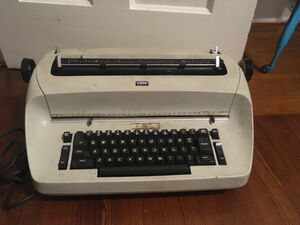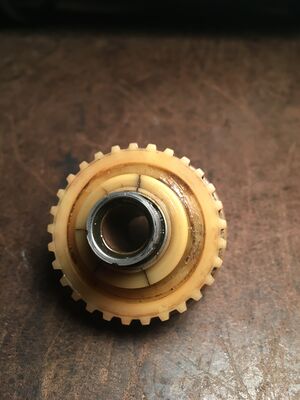Difference between revisions of "IBM Selectric"
RandomGemini (talk | contribs) |
RandomGemini (talk | contribs) |
||
| Line 10: | Line 10: | ||
The IBM Selectric's typeball gives it some major advantages over a traditional typewriter. Typeballs can be swapped out quickly allowing for multiple typefaces on one machine, the selecting mechanism is much faster than a traditional typewriter, and some machines are even equipped with IBM's "Dual Pitch" option which allows the machine to type in both 10 cpi (Pica) and 12 cpi (elite). | The IBM Selectric's typeball gives it some major advantages over a traditional typewriter. Typeballs can be swapped out quickly allowing for multiple typefaces on one machine, the selecting mechanism is much faster than a traditional typewriter, and some machines are even equipped with IBM's "Dual Pitch" option which allows the machine to type in both 10 cpi (Pica) and 12 cpi (elite). | ||
| − | The typeballs for all Selectrics are not all interchangeable. The Selectric I and II require typeballs that are labeled in white. The Selectric III can only use typeballs labeled in | + | The typeballs for all Selectrics are not all interchangeable. The Selectric I and II require typeballs that are labeled in white. The Selectric III can only use typeballs labeled in yellow. The difference between these typeballs is the number of characters available on the typeball itself. |
=Common Issues= | =Common Issues= | ||
Revision as of 20:42, 9 March 2022
History and Basic Info
The IBM Selectric typewriter was introduced on the 31st of July, 1961. This typewriter is equipped with a golfball sized type element instead of a type basket so that typefaces can be easily interchanged. The series started with the IBM Selectric (It's original designation does not include a I, but for consistency's sake, people usually call it the "IBM Selectric I" or just "Selectric I") , which evolved into the IBM Selectric II, and finally the IBM Selectric III. Selectrics came in a few sizes; (from smallest to largest) the Personal, 12",13" and 15".
The Typeball
The IBM Selectric's typeball gives it some major advantages over a traditional typewriter. Typeballs can be swapped out quickly allowing for multiple typefaces on one machine, the selecting mechanism is much faster than a traditional typewriter, and some machines are even equipped with IBM's "Dual Pitch" option which allows the machine to type in both 10 cpi (Pica) and 12 cpi (elite).
The typeballs for all Selectrics are not all interchangeable. The Selectric I and II require typeballs that are labeled in white. The Selectric III can only use typeballs labeled in yellow. The difference between these typeballs is the number of characters available on the typeball itself.
Common Issues
Due to their reliance on lubrication and complexity, IBM Selectrics will often not work when you first get your hands on it. Some times they won't even turn on. There are (usually) about 3 different issues that are universal to every machine.
- The first major issue is grease and oil. Selectric repairmen often greased and oiled every little nook and cranny on these machines to keep them running smoothly. Unfortunately, after sitting for 30-40 years, this grease will dry out, harden, and/or become extremely gummy. This, as you can imagine, is not good for the machine. You will want to bring it into a shop to have it done professionally, or if you are feeling adventurous, you can do it yourself with the help from some repair and adjustment manuals and some youtube videos.
- The second major issues is the central drive hub. These were made out of plastic hubs with metal cores. Usually there is nothing wrong with the metal core. The issue is the plastic hub. These are somewhat fragile, and after many years of use and/or sitting, they crack. A cracked hub will only hold together for so long and will eventually crack fatally. Duane from Pheonix Typewriter has a very good repair to this issue, linked here
- The third major issue is the drive belt. These will often shed teeth after sitting and disintegrating for many years on startup. Sometimes these belts are ok, but often they need replacing.

